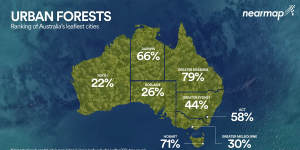Cities make up only 2 per cent of the land area,but house more than 50 per cent of the world’s population and are responsible for roughly 70 per cent of emissions,meaning they offer some of the best opportunities to reduce carbon emissions.

This is the first of a five-part series WAtoday will run on how Perth can reach net zero.Graphic design:Kathleen Adele
But in WA the conversation about how to quickly decarbonise the Perth metropolitan area has been neglected.
From this vacuum,the Net Zero Perth collaboration was born. Net Zero Perth (and predecessor #designperth) is a collaborative project that reaches across the usual divides to find the solutions that need to happen to not only reduce emissions,but to realise a more liveable and better-connected Perth.
Net Zero Perth is a collaboration including experts from WA’s universities,industry,and peak bodies in transport,development,planning,property,and local government. This group has been meeting throughout 2022,brought together by a desire to speed up WA’s transition.
Perth is one of the world’s worst-performing cities for emissions and its people are the.
A major reason is decades of suburban sprawl have seen Perth become one of the longest cities in the world. For many sandgropers,this means enduring long drives to work,to the shops,and even to our children’s schools. Catching public transport,walking,or riding is often unviable. Unsurprisingly,this makes Perth a largely car-dependent place and we have the.
We are also the Australian city with the biggest houses and the city with the lowest tree canopy cover.
New suburbs containing big houses squeezed onto small blocks with no leftover space for trees can be. We are in danger of creating suburbs a long way from anywhere,that are air-conditioning-dependent heat islands.
I could go on,but Net Zero Perth isn’t about being negative – it’s about practical solutions we can all agree on. Cities are made by choices,and Net Zero Perth reflects a rapidly growing consensus that Perth can choose a different future.
But it’s going to require different questions and choices.

Australia’s greenest – and least-green – cities.Nearmap
What kind of communities can we build if good low-carbon design is at the heart of our thinking? What if we demote the private car and place people,public transport,and cycling at the top? How can we get our city powered entirely by our wind and sun? How do we make buildings cheaper to run? How can we embed nature and greening back into our suburbs to make them cooler?
These questions are hard to answer,but too important to ignore,if we are to build inclusive,prosperous communities.
Perth continuing down its unsustainable business-as-usual path would be a failure of leadership and imagination.
Around the world,cities are leading the way in. From Adelaide to Amsterdam,Melbourne to Minneapolis,and Sydney to San Francisco they are showing how it is done.
But for Perth,the city with the highest emissions () there is no plan,whether that be for just the City of Perth or the whole metro area. While we are seeing some local governments lead the way,our city as a whole is missing a broader,coordinated plan.
Over the next month,with as a backdrop,WAtoday will be running four further contributed pieces from Net Zero Perth members on how metropolitan Perth can reach net zero potentially as soon as the end of this decade.
They will cover the four major pillars that will need attention:built environment,transport,energy,and urban greening.
You will hear from a range of Perth’s best and brightest – and most influential – as they explain how our city can speed up the net-zero transition most governments say they have committed to. Experts in planning,building,transport,urban greening,and energy will show how Perth is well-placed for a net zero future – but only if we make different choices now in this vital decade,not in 2050.
Ultimately,whether we’re at the ballot box,on the streets,or making everyday decisions,it’s up to all of us to make this transition a reality.
Follow WAtoday on,, and for handpicked selections of the day’s biggest local,national and international news.